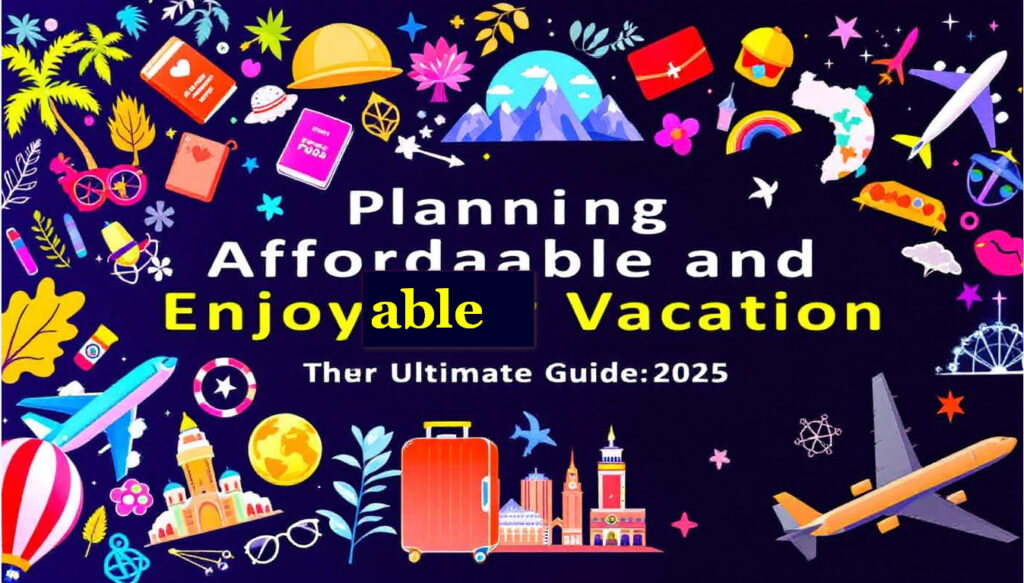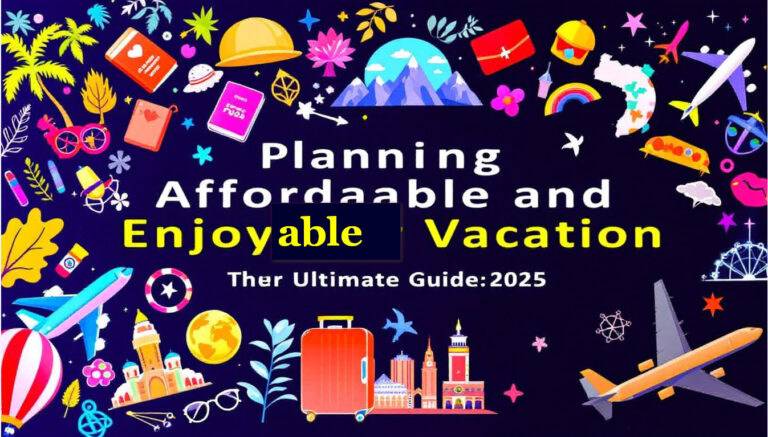Vacations don’t have to break the bank to be unforgettable. Balancing cost and fun might seem tricky, but with the right approach, it’s absolutely doable. Whether you’re dreaming of sandy beaches, mountain hikes, or cultural city tours, careful planning can help you create an affordable and enjoyable vacation without sacrificing quality. In this guide, I’ll share practical tips to make your next trip stress-free and memorable, no matter your budget. For more inspiration, check out this guide on planning a budget-friendly escape.
Table of Contents
Toggle
Pre-Trip Essentials
Planning an affordable and enjoyable vacation starts with getting the basics in order. Before you step into your dream destination, taking care of the primary details can save you time, money, and stress. Here’s how to ensure everything is in place for a smooth journey.
Validating Travel Documents
Before any trip—especially international ones—double-checking your travel documents is a must. Here’s how to make sure you’re good to go:
- Check your passport’s validity: Many countries require your passport to be valid for at least six months beyond your travel dates.
- Research visa requirements: Different countries have varying visa rules. Double-check the specific entry requirements for your destination.
- Keep copies of your documents: Make photocopies of all essential paperwork, including your ID, passport, tickets, and travel itinerary. Store these copies digitally and in hard copy for easy access during emergencies.
For a detailed checklist on what you’ll need for your trip, you can explore The Most Important Travel Documents for Your Trip or Traveler’s Checklist by Travel.gov.
Travel Insurance Basics
Travel insurance may not seem necessary until you really need it. Whether you’re dealing with an unexpected medical emergency, flight cancellations, or lost baggage, the right coverage can safeguard your vacation from unforeseen glitches.
Here are tips to help you choose wisely:
- Define your needs: Are you planning high-risk activities like skiing or diving? Opt for comprehensive coverage.
- Compare policies: Don’t settle for the first offer. Compare various providers to find the best combination of cost and benefits.
- Understand exclusions: Read the fine print to know what’s included—and what isn’t. For example, some policies don’t cover pre-existing conditions.
You can get insights on reliable insurance plans through resources like Before You Go by Travel.gov.
Health Preparations
Keeping your health in check ensures a more enjoyable vacation without unwanted interruptions. Before you pack your bags, ensure you’re fully prepared physically and medically.
- Check for required vaccinations: Some destinations may require specific vaccines. Check with your healthcare provider or visit the CDC’s travel health website.
- Pack essential medications: Bring prescribed medications and travel-friendly first aid essentials like pain relievers, antihistamines, and band-aids.
- Stay updated on health advisories: Be aware of outbreaks or health concerns in your destination.
To further ensure your safety and health, review Preparation Steps for Healthy and Safe International Travel.
Organizing these essentials gives you peace of mind and lets you focus fully on enjoying your trip.
Budget-Friendly Travel Tips
Traveling on a budget doesn’t mean sacrificing the quality of your experience. With proper planning and smart strategies, you can enjoy an incredible vacation without breaking the bank. Whether it’s finding affordable lodging, saving on meals, or sticking to a well-thought-out budget, these tips are here to guide you toward a cost-conscious and memorable trip.

Photo by Mikhail Nilov
Setting Your Travel Budget
The first step to keeping your trip affordable is setting a clear-cut travel budget. This acts as your blueprint and ensures you stay within spending limits. Here’s how you can achieve that:
- Divide expenses into categories: These might include flights, lodging, food, transportation, attractions, and a small allowance for unexpected costs.
- Use tracking apps: Budget apps like Mint or PocketGuard can help monitor your spending in real-time. They’ll send alerts if you’re nearing your limits for any category.
- Plan for emergencies: Set aside an emergency fund, even if it’s just a small buffer. You can’t always predict when surprise expenses will pop up.
Sticking to a predetermined budget will offer peace of mind. For more tips on managing your finances, take a look at 10 Practical Ways to Save Money from Your Salary.
Saving on Flights and Lodging
Airfare and accommodations often take up a sizable chunk of your travel budget. But with a few clever tricks, you can significantly cut these costs.
- Book flights during sales: Subscribe to price alert tools like Google Flights to snag deals during off-peak times. Flexible travel dates can significantly reduce airfare costs.
- Choose alternative lodging: Instead of upscale hotels, consider budget-friendly options such as hostels, Airbnb, or even homestays.
- Loyalty programs and points: If you’re a frequent traveler, sign up for airline or hotel loyalty programs to rack up points that can be redeemed later.
Want more advice? Check out How to Travel on a Budget for detailed airfare-saving tips.
Food and Dining on a Budget
Food is an integral part of any trip, but dining out every day can quickly add up. Here’s how you can keep costs manageable without compromising on flavor:
- Explore local markets: Not only are they budget-friendly, but they also let you experience the local culture.
- Try street food: Many destinations boast delicious and affordable dishes sold by street vendors. Just make sure they follow clean practices.
- Dine smartly: Look for “lunch specials” or early bird menus at restaurants, which are usually cheaper than dinner servings.
- Cook your meals: If your lodging has a kitchen, use it to prepare breakfasts and simple meals with ingredients sourced at nearby grocery stores.
For further food savings and ideas, browse Reddit’s Top Travel Tips for Eating Cheap.
With these strategies, you can enjoy your vacation without financial stress. Stay tuned for the next section, where I’ll discuss more ways to maximize your travel experience on a budget.
Packing Guide
Packing smartly for your vacation can make all the difference between stressful luggage chaos and breezy travel enjoyment. If your suitcase feels like a jigsaw puzzle, don’t worry—I’ve got practical tips to help you pack light, organized, and stress-free.

Photo by Timur Weber
Packing Efficiently
Packing efficiently isn’t about squeezing your entire wardrobe into one bag; it’s about being intentional. Here’s how to make the most of your luggage space:
- Stick to light layers: Opt for versatile clothing that you can mix and match. For example, pack plain t-shirts, cardigans, and neutral pants or skirts, which all work together seamlessly.
- Roll, don’t fold: Rolling clothes not only saves space but also reduces wrinkles. Tightly roll each item to make the most of your suitcase.
- Use packing cubes: Compartmentalize outfits into categories—daywear, evening attire, or workout clothes. This keeps your suitcase organized and speeds up packing and unpacking.
Here’s a quick packing checklist for an organized trip:
- Clothing (layered for versatility)
- Comfortable walking shoes (essential for exploring)
- Reusable water bottle
- Toiletries in travel-size containers
- Copies of important documents
If you’re looking for an in-depth travel packing list, I recommend checking out The Ultimate Travel Packing List For Any Vacation.
Essential Items to Pack
While outfits and shoes dominate most travelers’ focus, forgetting small essentials can lead to headaches later. Here are must-have accessories to add to your packing arsenal:
- Universal power adapter: Whether you’re traveling to Europe, Asia, or the Americas, a universal power adapter ensures your devices stay charged.
- Portable charger: Keep your phone and gadgets powered on the go—ideal for when you’re exploring all day.
- Travel-sized first aid kit: Include basics like pain relievers, plasters, and antiseptic wipes. It’s always better to be prepared.
- Travel lock: A small but effective way to keep your belongings safe, especially in shared accommodations or crowded spaces.
- Reusable zip bags: Useful for keeping toiletries leak-proof or separating dirty laundry.
For an expansive guide to packing smart, explore Packing like a pro: The ultimate guide to what to bring. It’ll help cover every possible packing scenario!
With these tips and tricks, you’re ready to pack like a pro. Imagine less time fussing with your bags and more time enjoying your vacation—because that’s the goal, right?
Destination Research
Planning an affordable and enjoyable vacation requires more than just sorting out the logistics. Understanding your destination deeply can elevate your travel experience, save money, and ensure you’re well-prepared. Researching cultural norms, safety measures, and even the local language can make your trip safer and more fulfilling.
Cultural Awareness: The Importance of Respecting Local Customs and Traditions
When you travel, you’re entering someone else’s world—complete with unique traditions, customs, and ways of life. Being culturally aware not only shows respect but also opens the door to genuine interactions with locals. For instance, in Thailand, pointing with your feet is considered offensive, while in Japan, tipping could be seen as rude. These small cultural insights prevent accidental disrespect.
Here’s how you can practice cultural awareness effectively:
- Research beforehand: Learn basic etiquette like greetings, dining customs, and gestures. Websites like How to Practice Cultural Sensitivity During Meaningful Travel provide detailed insights.
- Observe first: Before diving into local interactions, take a moment to observe how locals behave in public—this can guide your actions.
- Ask respectfully: If unsure about a practice, don’t be afraid to ask locals. Most people appreciate the effort and are happy to educate.
When you embrace cultural awareness, you bridge gaps and foster meaningful connections with the people you meet.
Travel Safety Basics: Researching Safety Practices, Scams, and Personal Security
Staying safe while traveling starts with due diligence. Each destination will have its unique risks, and a little research can go a long way in ensuring a trouble-free trip. For example, in some popular tourist cities, pickpocketing might be common, while in others, health precautions like vaccines are critical.
Follow these safety basics to stay ahead of potential risks:
- Identify common scams: Scammers often target tourists with tactics like overcharging taxis or fake tours. Reading about these ahead on platforms like Nobellifestyle’s Safety and Travel Tips can arm you with knowledge.
- Store important info: Keep a copy of emergency contact numbers, including local embassies and police stations. Store these both digitally and on paper.
- Blend in: Avoid appearing like a tourist by dressing to match local styles and avoiding flashy accessories.
Even small steps, like sticking to well-lit streets or using ride-hailing apps over street taxis, can make a big difference in your security.
Learning the Language: Using Key Phrases and Language Resources to Enhance Travel
Learning even just a few key phrases in the local language can greatly enhance your travel experience. Imagine being in Spain and asking locals for their favorite tapas spot in Spanish—it immediately garners warmth and a sense of camaraderie.
Here are some practical tips for mastering the basics:
- Start with essentials: Learn simple phrases like “hello,” “thank you,” and “where is the restroom?” to have your bases covered.
- Use language apps: Resources like Duolingo or Babbel make it easy to pick up conversational phrases before your trip.
- Carry a phrasebook: In case your phone dies or apps aren’t accessible, a pocket phrasebook can work wonders.
- Practice pronunciation: Locals appreciate the effort, even if your accent isn’t perfect.
Effortlessly combining basic phrases with gestures conveys thoughtfulness and helps you navigate interactions better. If you need more help, platforms like Nobellifestyle frequently share valuable travel preparation tips that simplify your experience.
By prioritizing destination research, you prepare yourself to travel smarter and with greater confidence. Taking the time upfront allows for a smoother, more enjoyable journey where you can focus entirely on making memories.
Travel Planning and Flexibility
Planning the perfect vacation means striking a balance between structure and spontaneity. While it’s tempting to nail down every detail, leaving room for flexibility can actually enhance your experience and help avoid stress. From creating a loose itinerary to effectively managing potential risks, here’s how to master the art of flexible travel planning.

Photo by Vlada Karpovich
Building a Flexible Itinerary
A well-structured itinerary serves as a roadmap, but the key to making it work is leaving space for the unexpected. Here’s how to design a day-by-day plan that accommodates both structure and spontaneity:
- Set priorities: Focus on major attractions or experiences you don’t want to miss and schedule them early in your day.
- Plan blocks of free time: Allocate time for exploring new spots, relaxing, or pursuing recommendations made by locals.
- Use flexible booking options: Opt for accommodations or activities that allow cancellations or modifications without hefty penalties.
- Limit overloading: Try not to plan every hour of your day to prevent burnout. A vacation shouldn’t feel like a race.
Flexibility in your itinerary can make room for delightful surprises, like a hidden café or an impromptu local festival. For more tips on maintaining a loose schedule, check out Staying Light & Flexible While Traveling.
Managing Risks
Travel always comes with a set of uncertainties, from weather disruptions to unexpected expenses. However, a bit of foresight can help you navigate these hurdles effortlessly:
- Pack essentials: Always have a travel kit with snacks, a power bank, and a first-aid kit. These seemingly small items can be lifesavers.
- Secure reliable travel insurance: A comprehensive policy can protect you from last-minute cancellations, lost luggage, or emergencies.
- Plan alternatives: If you’re visiting an outdoor destination, make a note of indoor activities or nearby towns you can explore in case of bad weather.
- Stay updated on local conditions: Download travel apps for alerts about flight delays, weather changes, or important announcements.
Facing potential disruptions is easier when you plan ahead, giving you peace of mind throughout your journey. For expert strategies, you can explore Tips from the Experts: How to Book Flexible Travel Plans, which dives deeper into flexibility for smooth vacation planning.
By building adaptability into your plans, traveling becomes more enjoyable and less stressful. Who knows? That detour might lead to the highlight of your trip!
Tools and Resources for Trip Planning
Planning an affordable and enjoyable vacation starts with choosing the right tools. From booking flights and accommodations to managing your budget and finding your way in a new city, having reliable apps and resources can make the process smoother and less stressful.

Photo by Porapak Apichodilok – A smartphone showcasing essential apps for travel planning.
Best Travel Apps and Platforms: Overview of top tools for bookings, budgeting, and navigation
Today, technology offers a variety of apps designed to handle nearly all aspects of travel planning. Whether you’re hunting for affordable flights or crafting your itinerary, there’s likely an app for it. Here are a few standout ones:
- Google Maps: A lifesaver for navigation, Google Maps also allows you to download maps offline, making it handy when exploring areas with poor network coverage.
- Hopper: This app predicts flight prices, helping you decide whether to book now or wait for a better deal. It also works well for hotel bookings.
- TripIt: Perfect for organizing all your travel details in one place. You can forward booking confirmations to the app, and it creates a master itinerary for your trip. Learn more about TripIt on the App Store.
- Wanderlog: A robust tool for planning multi-stop road trips, enabling you to share the itinerary with friends. Some have even dubbed it “the travel planner to replace spreadsheets.” Check out Wanderlog’s benefits.
Additionally, platforms like Expedia and Kayak offer competitive pricing for flights and accommodations while providing flexibility for cancellations or changes.
With these tools, staying on track financially and logistically becomes much easier, allowing you to focus on the fun side of travel.
Handy Downloadables: Provide links to printable checklists and planners
Sometimes, having a tangible planner or checklist in hand simplifies the process of staying organized. Whether you prefer digital tools or good old-fashioned printouts, checklists ensure nothing gets overlooked.
Here’s what to look out for:
- Packing Checklists: Break it down by category—clothing, toiletries, documents, and electronics. Create separate ones for carry-ons and checked luggage.
- Itinerary Planners: For those who like detailed day plans, printable templates for multi-stop trips are widely available.
- Budget Trackers: Keeping track of expenses midway helps ensure you stay within your vacation budget.
If you’re looking for guidance on creating a budget, take inspiration from this practical approach to managing vacation expenses.
Printable content is easy to find on Pinterest or can be created using apps like Canva for a more personalized touch. For those who want to skip the hassle, ready-made templates are shared across digital travel forums, including Reddit’s TravelHacks Community.
By combining apps and printable planners, you’ll have a balanced system to manage your next affordable and enjoyable vacation with confidence.
Adding the Personal Touch
Creating a vacation filled with personal touches makes your trip stand out from cookie-cutter travel experiences. It’s not about spending lavishly—it’s about finding activities and crafting moments that reflect your interests and individuality. Here’s how you can curate unique experiences and share travel wisdom to make your trips truly memorable.
Incorporating Unique Experiences: Tips for finding offbeat activities and affordable cultural experiences
Uniqueness doesn’t have to come with a hefty price tag. Many hidden gems and cultural experiences can be surprisingly affordable when you know where to look. The trick is to go beyond the obvious tourist attractions and discover what makes a destination truly special.
- Get recommendations from locals: Locals often know the best-kept secrets of their city. Whether it’s a hidden café, a less-traveled hiking trail, or a peaceful park, asking for suggestions can lead to incredible finds. Platforms like Experience Culture Travel can also help you uncover cultural adventures tailored to your preferences.
- Attend free or low-cost cultural events: Explore local markets, festivals, or art gallery openings. These events often showcase the area’s culture and don’t require hefty entrance fees. I’ve found that weekend markets or food festivals are particularly great for sampling local flavors without blowing your budget.
- Seek offbeat tours: Instead of traditional tours, look for unique options such as food walks, bicycle tours, or heritage trails. Companies that focus on sustainability and local immersion often create rich, authentic experiences that cost less than luxury tours.
For a deeper dive into unforgettable experiences around the world, you might enjoy reading 45 Unique Cultural Experiences to Inspire Your Next Trip. You’ll find plenty of ideas to spice up your itinerary without spending extra.
Sharing Advice: Offer personal lessons and travel hacks for enhancing trips
Traveling often teaches us lessons that no guidebook could prepare us for. Sharing these insights with others not only helps them but also allows you to reflect on how to make your next trip even better. Here are a few tips I rely on:
- Pack smarter, not heavier: Overpacking is one of the most common travel mistakes. Instead, focus on versatile clothing pieces, like neutral T-shirts or wrinkle-free trousers. Packing cubes can also help you stay organized and make it easier to locate items in your luggage.
- Use travel-friendly apps: Booking flights and accommodations has never been easier with tools like Hopper and Google Maps. They can track prices and make navigating new cities a breeze. For those who enjoy more detailed planning, apps like TripIt can sync your entire vacation itinerary. Learn more about them in this overview of top tools for bookings, budgeting, and navigation.
- Communicate thoughtfully: Knowing a few key phrases in the local language can go a long way. It’s not just about getting help when needed—it shows respect for the culture and fosters genuine connections. If learning languages quickly feels daunting, apps like Duolingo can give you a head start.
Being intentional and open-minded as you travel often leads to the most cherished memories. And don’t forget, the travel hacks that work for you might inspire someone else—so share generously!
Calls to Action
A well-crafted Call to Action (CTA) is more than just a phrase—it’s your opportunity to guide your audience toward meaningful engagement. Whether you’re looking to inspire readers to book a trip, subscribe to a newsletter, or even try something new for their vacation, a clear and persuasive CTA can make all the difference. Here, I’ll break down essential tips and strategies for creating impactful CTAs that resonate with your audience and align with your travel goals.
Why Effective CTAs Are Essential for Vacation Planning
When planning a vacation, CTAs serve as handy prompts that help streamline decisions. Think about how often you’re faced with choices while browsing travel websites or apps—like booking a hotel, comparing flight prices, or researching itinerary ideas. Without clear CTAs to steer you, the decision-making process can feel overwhelming. Effective CTAs, like “Find Your Perfect Getaway Today” or “Start Planning Now,” not only simplify this process but also encourage action at crucial moments.
If you’d like to dive into real-world examples of effective CTAs, check out this comprehensive article featuring CTA examples. It provides incredible insights into how small tweaks in wording can truly boost engagement.
Crafting CTAs That Work
Not all CTAs are created equal. They need to meet the needs of your audience while also aligning with your personal travel goals. Here are some tips to create better CTAs:
- Be Specific: Vague commands like “Click Here” often go unnoticed. Instead, use detailed prompts like “Compare Budget Hotels in Your Area” for clarity.
- Add a Sense of Urgency: Words like “Limited Offer” or “Book Today To Save 20%” encourage readers to take immediate action.
- Keep It Concise: CTAs should be short and impactful. Remember, less is more.
For more insights and best practices on CTAs, you may find this glossary explanation of CTAs helpful in understanding how they’re applied in different contexts.
Examples of Travel-Related CTAs
Here are some real-world examples tailored for affordable vacation planning:
- “Save Big: Plan Your Trip Under $1,000!”: This CTA appeals to those seeking budget-friendly deals and creates excitement for affordable travel.
- “Explore Scenic Destinations on a Budget”: Encouraging exploration while staying within financial limits.
- “Get the Best Flight Deals Now!”: Ideal for snagging last-minute discounts or promoting price comparison platforms.
By tailor-making CTAs for your specific goals, you can turn casual browsers into enthusiastic travelers.
For more examples of how CTAs shape marketing strategies effectively, explore this guide on perfecting CTAs.
Best Placement Strategies for CTAs
Ultimately, the placement of CTAs across your website or travel materials is just as critical as the wording itself. You’ll want to position CTAs where they’re impossible to miss but don’t disrupt the user’s experience. Here are some handy tips:
- Above the Fold: Place your initial CTA where it’s visible as soon as someone lands on your page.
- Throughout the Content: Seamlessly insert CTAs at natural breaks in your text, such as at the end of travel tips or packing guides.
- In Confirmation Emails: After booking, include CTAs like “View Your Itinerary” or “Discover Nearby Attractions.”
For more guidance on CTA optimization across platforms, take a look at this concise resource from Mailchimp.
Integrating CTAs effectively into your vacation planning resources ensures your audience can act easily and confidently, paving the way to an affordable and enjoyable travel experience.
FAQs
Many travelers, especially those planning their first trip, have common questions about balancing affordability and enjoyment. Below, I’ve answered some frequently asked questions to help you make informed decisions and maximize your vacation experience.
What are some affordable travel destinations for first-time travelers?
If you’re new to traveling, starting with budget-friendly destinations can make a big difference. Some of the best options include:
- Thailand: Known for its delicious street food and low-cost accommodations, Thailand offers an incredible experience without stretching your wallet. You can enjoy beach towns like Krabi or explore cultural hotspots such as Chiang Mai.
- Portugal: With affordable public transport and reasonably priced dining, Portugal is perfect for first-timers looking for a mix of history and stunning landscapes.
- Mexico: Cities like Oaxaca and Puebla boast a rich blend of culture and cuisine. They’re budget-friendly with low-cost lodging and street food options.
For more beginner-friendly ideas, check out Discover the Best Places to Travel for Beginners.
How far in advance should I start planning my vacation?
The best time to start planning your vacation depends on several factors, such as your destination, travel dates, and personal preferences. In general, it’s a good idea to start early to secure the best options and avoid last-minute stress.
For international trips, begin planning at least six to twelve months ahead. This allows enough time to research destinations, book flights, and secure accommodations, especially for popular tourist spots. If you’re traveling during peak seasons, like holidays or summer, starting closer to a year in advance can help lock in lower prices and better availability.
For domestic trips, you might only need three to six months, depending on how far you’re traveling and how flexible you are. Weekend getaways or short trips may only require a few weeks to a couple of months to plan, especially if you’re not traveling during busy times or don’t need specific accommodations.
If you’re looking for deals, booking two to three months in advance often offers a balance between affordability and availability. Last-minute discounts can work, but they’re unpredictable and not ideal if you have specific preferences or needs.
Ultimately, the earlier you start planning, the more options you’ll have, and the smoother the process will likely be. Consider your schedule, budget, and travel goals to decide what makes sense for you.
Planning your trip ahead of time can save you money and stress. Here’s a rough timeline:
- Domestic Trips: Start at least 2-3 months in advance. This gives you enough time to find deals on flights and accommodations without spikes in prices.
- International Trips: Begin planning 6-9 months out. Booking early can help you secure better rates, especially during peak seasons.
Remember, flexibility with your travel dates can lead to significant savings.
What is the best way to save on last-minute travel deals?
Sometimes plans come together at the last minute, and that’s okay! You can still snag great deals with a bit of effort:
- Visit deal websites: Platforms like Skyscanner or LastMinute.com specialize in offering flight and hotel bundles for last-minute travelers.
- Seek package deals: Booking flights and lodging together often reduces overall costs.
- Be flexible: Your chances of finding affordable options increase if you’re open to alternative destinations or travel dates.
These strategies make it possible to enjoy spontaneous trips without overspending.
How do I handle currency exchange when traveling abroad?
Currency exchange doesn’t have to be intimidating. Here’s how you can minimize fees and get better rates:
- Use a travel card: Opt for credit cards that don’t charge foreign transaction fees. Some cards even offer better exchange rates than banks.
- Avoid airport currency exchange booths: These are notoriously expensive. Instead, withdraw cash from local ATMs using a low-fee debit card.
- Compare exchange options: Research rates in advance with apps like XE Currency or OANDA.
By staying mindful of these tips, you’ll keep your travel budget intact.
What’s the ideal length for a vacation to stay within budget?
The duration of your trip plays a crucial role in overall affordability. Here’s a guideline based on different budgets:
- Shoestring budget: Short getaways (3-5 days) work well. A long weekend in a nearby destination can be cost-effective.
- Mid-range budget: A week-long trip allows you to explore more thoroughly without overspending.
- Flexible budget: If you’ve saved up, 10-14 days is a sweet spot for balancing relaxation and exploration.
If you’re deciding how long your trip should be, remember that longer stays often mean more spending. Choosing a manageable timeframe ensures you enjoy your vacation stress-free. For more tips on optimizing trips, visit 21 Best Places to Travel on a Budget in 2024.
This FAQ section offers practical insights to make your next vacation budgeting and planning smoother.
Conclusion
Planning an affordable and enjoyable vacation is within reach when you approach it with careful preparation and a clear strategy. From prioritizing your budget to packing intentionally and researching your destination, every step contributes to a more fulfilling travel experience.
This guide equips you with practical tools to make your journey memorable without overspending. Start small by drafting a budget, exploring cost-saving resources, and identifying experiences that truly resonate with you.
Planning ahead ensures you’ll make the most of your adventure, whether you’re chasing serene landscapes or rich cultural experiences. Ready to embark on this journey? Start planning your dream trip today and explore more resources on affordable travel here.









